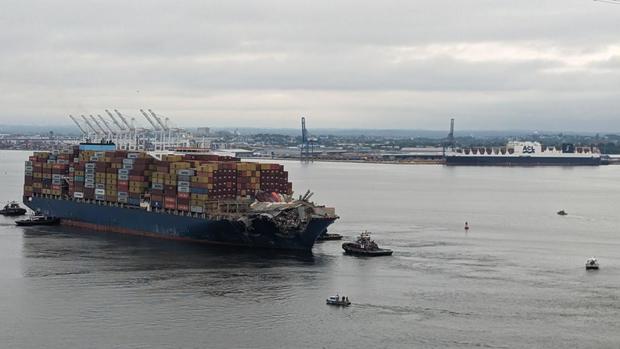Dali refloated weeks after collapse of Key Bridge, a milestone in reopening access to the Port of Baltimore. Here's what happens next
BALTIMORE -- The Dali, the 948-foot-long cargo ship stuck in the Patapsco River for weeks after it felled the Francis Scott Key Bridge, was refloated Monday morning, according to the U.S. Army Corps of Engineers.
It is a massive milestone in the effort to salvage the wreckage from the disaster and reopen access to the crippled Port of Baltimore. Tugboats escorted the ship to a local terminal.

The milestone comes nearly eight weeks since the malfunctioning ship struck the bridge, causing its collapse and killing six construction workers, cutting off the port and demolishing part of I-695.
Unified Command, a multi-agency effort in the Key Bridge response, has said its priority is to restore the full depth and width of the Fort McHenry channel, allowing pre-collapse traffic patterns in and out of the port. The team intends to do that by the end of May.
How was the ship refloated?
The process to refloat the ship and the salvage effort has been delicate and dangerous, involving giant floating cranes to move debris and relocate shipping containers, and using explosives to move tons of mangled steel and roadway.
Unified Command began preparing for the refloat operation Sunday afternoon, aiming to catch the high tide early Monday morning.
"The refloat and transit sequence is deliberately designed to ensure all response personnel around the M/V Dali maintain control of the vessel, from refloat, transit to, and berthing at a local marine terminal," Unified Command said Saturday.
Preparations included the release of anchors, de-ballasting the ship, and detailed inspections for any obstructions.
Dali arrives at Seagirt Marine Terminal
The relocation of the ship, which is about the length of three football fields, brings Unified Command close to reopening the federal channel.
The ship traveled at a speed of 1 mile per hour, making its way to Seagirt Marine Terminal.
A giant hydraulic claw will make that possible by removing pieces of the bridge embedded in the Patapsco River bed.
At the local terminal, any remaining wreckage on the ship will be offloaded and taken to Sparrows Point for recycling or disposal.
Dali's crew of 22 has remained on the ship since the March 26 accident, and will remain on the ship as it's transported. The crewmembers do not have the appropriate visas to leave the ship, our media partner the Baltimore Banner reported, so they rely on organizations to bring them essentials.
It was not immediately clear if and when the malfunctioning ship might be able to sail again to leave the Port of Baltimore.
Investigations ongoing, lawsuits launched
Since the collapse, the FBI and NTSB have launched separate investigations into the incident and Baltimore City announced a lawsuit against the owners and managers of the cargo ship, alleging negligence.
Maryland Attorney General Anthony Brown was approved last week to contract five external law firms to assist in litigation over the collapse.
The Dali lost electrical power multiple times before leaving the Port of Baltimore and crashing into the Key Bridge, according to a preliminary report released last week by the National Transportation Safety Board..
The lawsuit claims the Singapore-based owners of the Dali were negligent in letting the ship leave the Port of Baltimore without fixing known power problems.
A final NTSB report, which would include conclusions and safety recommendations, should come in a year or two. You can read the full NTSB preliminary report here.
Rohan MattuRohan Mattu is a digital news producer at CBS News Baltimore. Rohan graduated from Towson University in 2020 with a degree in journalism and previously wrote for WDVM-TV in Hagerstown. He maintains WJZ's website and social media, which includes breaking news in everything from politics to sports.
Disclaimer: The copyright of this article belongs to the original author. Reposting this article is solely for the purpose of information dissemination and does not constitute any investment advice. If there is any infringement, please contact us immediately. We will make corrections or deletions as necessary. Thank you.




